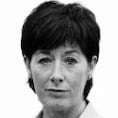1 Celebrity endorsements: “When you’re hot you’re hot” is not an absolute. With 9 million Twitter followers, his own TV channel, a book in Amazon’s top 100 and an equal opportunities pawing policy, comedian Russell Brand believed he could “probably influence the outcome of an election”. Cue Bonfire of The Vanity.
2 Political types: Business/life experience won out over party loyalty/experience/ideology. Only 4 per cent of Labour MPs ever worked in finance compared to 25 per cent of the winning Tories. No doubt the Irish Postmasters’ Union has clocked the new Tory MP for Cornwall: he’s a postman.
3 Age: average age has fallen below 50 for the first time in the House of Commons (partly because of 20-year-old Mhairi Black). Each decade, surprisingly, is close to equally represented: 95 under-29s, 95 under-39s, 95 under-49s, 98 under-59s and 103 over-60s.
4 Austerity: no bar to re-election. Years of cuts, depressed wages and rows about the health service failed to shift the British electorate.
5 Opinion polls: really are just a snapshot in time. The BBC for example, is not allowed to lead with them in news bulletins. It's all about context, say the gurus. No party loses an election which is ahead in the polls on choice of PM and economic competence at the same time. Which Cameron was.
6 Dull campaigns: can be sensational winners. The Tories’ dogged, dull, silent “micro targeting” of wobbly voters versus Labour’s “ground war”/“five million conversations”? No contest. The figures men triumphed – partly by not treating Ukip as a homogenous lump.
7 “Shy Tories”: not necessarily. There were genuine ballot-box conversions from Labour to Conservative, mostly because of the Tory-inspired scaremongering about a Labour-SNP coalition.
8 The wisdom of groundlings: Labour MPs claim they tried to warn Ed Miliband mid-campaign that the scaremongering was hitting home. One claims Ed put the phone down on him.
9 Electoral turnout: total number of Scots registered to vote? 97 per cent. Turnout in last year’s referendum: 85 per cent. Turnout in this election: 71.1 per cent. It puts them five points ahead of the rest of the UK (in itself the highest turnout since Tony Blair’s glad, confident morning) but is it a just a tad disappointing in such an explosively emotive election?
10 The ascendancy of women: Westminster is less “male, pale and stale” than before. The average MP is still likely to be a man about 50 and they outnumber women two to one. But for the first time, 30 per cent of British MPs are women, up seven points since 2010.
The interesting thing is the share of female MPs across the parties and regions. The high-water mark for Labour was 1997, when it brought in 101 women. It is surely a tribute to the women candidates, to the Labour Party itself, and to some initiatives by Commons speaker John Bercow, that after this disastrous campaign, some 43 per cent of its 232 MPs are women. The SNP is 36 per cent female. Out of the Conservatives’ stunning haul of 331 MPs, just 20 per cent are women.
To put that another way: in Westminster, Conservatives remain 80 per cent male; SNPs 64 per cent male; Labour 57 per cent. In Northern Ireland, the number of female MPs has been halved to two, making its MP roster 89 per cent male.
Shocking, isn’t it? And yet, their 11 per cent of women hardly looks all that disastrous beside the Republic’s 15.7 per cent. None of this is accidental. Labour introduced all-women shortlists in some target seats in 1997, with the aim of reaching 100 women MPs. In 2002, it introduced the Sex Discrimination (Election Candidates) Act 2002 (with a sunset clause that expires this year) allowing parties to use positive discrimination in candidate selection. In 2010, David Cameron indicated he would impose all-women shortlists but never got around to it for some reason. So between 2010 and 2015, the Tories managed to increase the number of female Tory MPs but only by four points in percentage terms.
Meanwhile, the SNP created a post of national women’s officer and used all-women shortlists in some seats this time, resulting in that haul of 20 female MPs.
Whatever you think of their politics, women leaders were startlingly, admirably, visible in this campaign. There was no tokenism here, no “honorary man”. The calm, likeable Nicola Sturgeon became the pivotal figure of this election. Westminster’s youngest MP in 180 years happens to be a woman. One 40-year-old candidate sold her house to fight full-time for the seat and won. Another with a tragic backstory triumphed over savage personal attacks and turned George Galloway’s 10,000-vote majority to ashes. It was women who pulled the rug from under big beasts such as Douglas Alexander, Ed Balls, Vince Cable and Norman Baker.
Election 2016 could get interesting yet.

